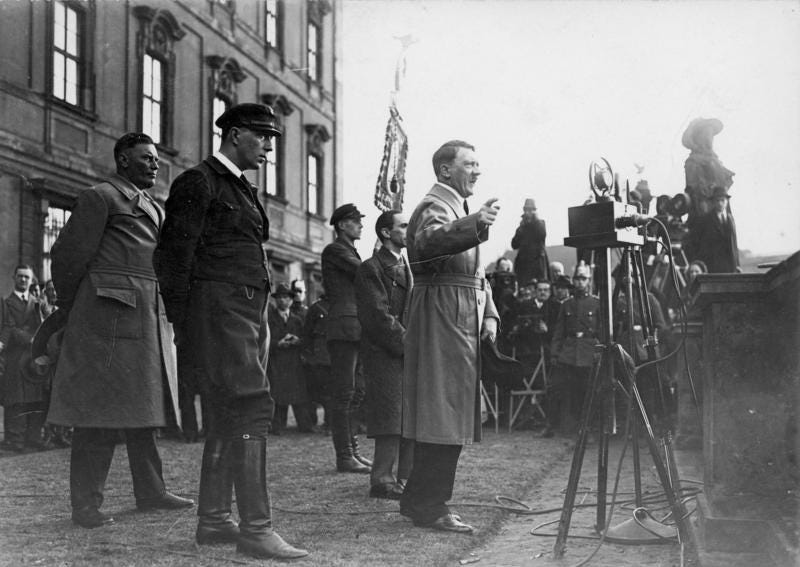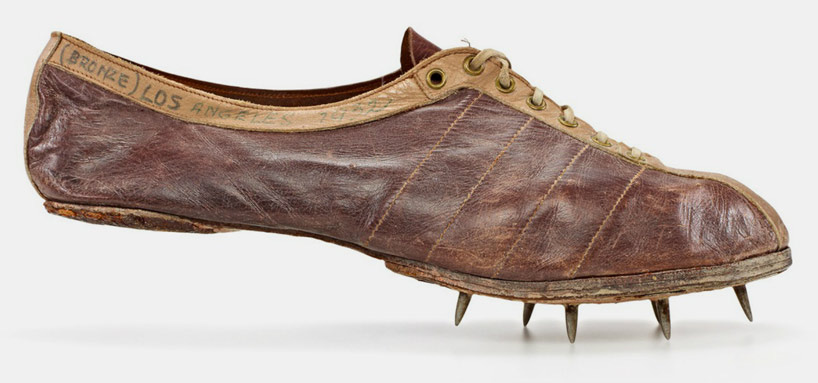Adolf “Adi” Dassler, an introverted Bavarian cobbler, began making shoes in his mother’s old laundry shed after the First World War. He was soon joined by his gregarious older brother Rudolf and by 1928 they were hand-crafting sprint spikes for the newly-reinstated German Olympic team, banned since the end of the war.
On this first day of track & field competition in Los Angeles, Arthur Jonath slipped on a pair of the Dassler Brothers sprint spikes for his 100-meter qualifying heats. The ex-boxer, turned sprinter was wearing the Waitzer model, named for Josef Waitzer, a former Olympian, coach, Reich Minister of Sport, and the shoe’s co-designer. Lightweight with thin calf leather uppers and narrow laces, the shoes featured an innovative asymmetric plate with six 3/4-inch-long hand-wrought spikes. Jonath hoped they would be perfect for chewing through the Coliseum’s cinder.
The track was fast. The weather perfect. The crowds exuberant. Jonath felt confident and was picked by some to challenge for the gold. Across his chest, he wore the black eagle crest of the disintegrating Weimar Republic. Back in Germany his compatriots were voting a dictator into power.
The Election
On July 31, 1932, 37 million Germans went to the polls in a record 84% voter turnout. And despite knowing what Hitler and the Nazis stood for after a decade of anti-Semitic, racist, ultra-nationalistic, anti-democratic, vengeful vitriol, 37% voted for the far-right Nationalsozialistische Deutsche Arbeiterpartei. They had doubled their vote total in less than two years and had become the largest party to ever sit in the Reichstag. Their popularity now extended throughout the country into the streets of Berlin. And yet, the Los Angeles Times maintained an optimistic tone, noting that the “Nazi movement has not yet reached its height, but it has lost its momentum” since Hitler had failed to achieve the outright majority that he so desired.

Chancellor Franz von Papen tried to reassure worried observers that Hitler did not seek a dictatorship. On some, it worked. Alongside stories of Olympic events, the Times opined that the Nazis would be “much less formidable in the Reichstag than the beer hall” and that the time for apprehension had passed since the election would lead to greater political stability. “Radicals… have one characteristic in common. If they are granted what they want when they want it, they no longer want it. The Nazis will be no different.”
But just six weeks earlier von Papen had lifted the ban on the Nazi’s paramilitary Schutzstaffel (SS) and Sturmabteilung (SA or “Storm Troopers”). Thousands of Germans, mostly opponents branded communists, were injured and more than a hundred died in the ensuing political violence. Hitler himself hailed the decree as “the forerunner of the coming seizure of power.” In six months he would fulfill his promise and dispense with democratic formalities.
Still Fighting the Last War in Los Angeles
The day before the election, at the Los Angeles opening ceremony, the German Olympic delegation was still fighting the First World War. Based on protocol, the Germans should have followed immediately after the French in the parade of nations but they refused. More than twelve years had passed since the “war to end all wars”, but there was no love lost between the two nations. The French had nearly boycotted the 1928 Olympics over Germany’s inclusion, while leading German newspapers refused to print the names of French medal winners. It was a curious moment, especially since the two had resumed international football matches the previous year. It was left to the British to play peacekeeper by marching between them, ignoring for the moment that a million young British men had also died fighting the same Germans.
The German men wore black and white peaked captain’s yachting caps, double-breasted gray blazers with the imperial eagle stitched into the breast pocket, and dark blue trousers. They were, according to the Los Angeles Times’ “quite a military looking outfit.” Led by heavyweight wrestler Georg Gehring, the 140 men and women of the team—what team manager Carl Diem called his country’s growing “youth movement”—represented the Nazi fixation with “national regeneration.”
One German athlete not included was Berlin-born fencer Ellen Preis. Born to an Austrian father and a German mother, Preis had moved to Vienna two years earlier but had expressed interest in representing her native land. The German Federation denied her request. She was Jewish.
It was not the Germans who flashed a fascist salute in Los Angeles, but Benito Mussolini’s blue-shirted Italians. Described as a marching “phalanx”, the all-male contingent entered to raucous applause, perhaps because onlookers mistook their gesture for a similar looking Olympic salute. The men—and they were all men despite Italy having had 18 female participants four years earlier—had received well wishes from Mussolini himself before they left Rome. He believed that a woman’s place was in the home and having earlier dispensed with any democratic pretense, his word was now law.

The Sad Epilogue
Carl Diem, after learning all that he could in Los Angeles, led the organizing committee for the 1936 Berlin Games. The Olympic torch relay, linking Ancient Olympia to what the Nazis believed was a master Aryan race, would prove to be his greatest innovation, and a propaganda coup.
German flag-bearer Georg Gehring would not live to see his 40th birthday. He, like hundreds of other Olympians, was killed in action in a war few saw coming on that beautiful summer day in Los Angeles.
Adolf Hitler would die by suicide in a Berlin bunker in 1945 after having caused more death and destruction than perhaps any other human being. His propagandist, Joseph Goebbels, committed suicide a day later after killing his six children and wife.
Adolf and Rudolf Dassler joined the Nazi party shortly after Hitler became chancellor. The brothers parted ways in 1948, paving the way for the creation of two global shoe brands, Adidas and Puma. To this day, both companies are headquartered in Herzogenaurach, Germany, the town of just 25,000 where the estranged brothers lived and died. (For those interested in learning the full story, Barbara Smit’s Sneaker Wars provides an excellent accounting).
And although Google Search’s AI would have you believe that Jesse Owens was the first man to win an Olympic medal in the Dassler Brothers’ shoes, you now know that is incorrect. Please, don’t trust everything you read.







Wow!!! It's incredible to see how intertwined those events, sinister figures, the Olympics, and the rise of sports giants like Adidas and Puma are with pivotal moments in history.
This is really excellent writing.